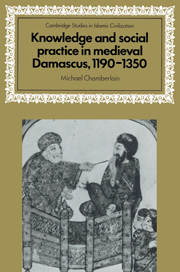Book contents
- Frontmatter
- Contents
- Preface
- List of abbreviations
- 1 Damascus and its surrounding region
- 2 Damascus in the thirteenth century
- Introduction
- 1 The acyān of Damascus, 590/1193–750/1350
- 2 Madrasas, the production of knowledge, and the reproduction of elites
- 3 Manṣabs and the logic of fitna
- 4 Social and cultural capital
- 5 Truth, error, and the struggle for social power
- Summary
- Bibliography
- Index
1 - The acyān of Damascus, 590/1193–750/1350
Published online by Cambridge University Press: 06 November 2009
- Frontmatter
- Contents
- Preface
- List of abbreviations
- 1 Damascus and its surrounding region
- 2 Damascus in the thirteenth century
- Introduction
- 1 The acyān of Damascus, 590/1193–750/1350
- 2 Madrasas, the production of knowledge, and the reproduction of elites
- 3 Manṣabs and the logic of fitna
- 4 Social and cultural capital
- 5 Truth, error, and the struggle for social power
- Summary
- Bibliography
- Index
Summary
In the high medieval period, Damascus was larger and richer than most other cities in the Middle East, and its inhabitants exploited a variety of sources of wealth. Outside the walls, and watered by the Barada river, was the agricultural plain of the Ghūta, which produced cash crops for landlords. Damascus was one of the wealthiest trading cities of the region, and straddled trade routes connecting the Mediterranean, Central Asia, Arabia, and the Indian Ocean. The city was also a political and administrative center, and at times an imperial capital. It attracted clerks and secretaries, poets, holy men, scholars, and soldiers from many parts of the Islamic world. It was a shrine center itself and benefited from the traffic in pilgrims to other holy places such as the Hijāz and Jerusalem. Yet, while Damascus supported landowners, merchants, holy men, bureaucrats, soldiers, and scholars, one of the striking continuities of the high medieval period is that elites of such varied types transmitted their status over generations by their control over property only with difficulty. Although it is clear that some households controlled property better than others, secure control of property over time never provided the stabilitas loci that it did in Europe.
There were several reasons for the disjunction between the long-term control of property and the power and status of acyān households. First, Islamic inheritance law, to the extent that it determined practice, obstructed the transmission of property intact through descent groups. Gifts inter vivos, benefices, and charitable foundations provided only partial expedients by which individuals could limit the large number of their heirs.
- Type
- Chapter
- Information
- Publisher: Cambridge University PressPrint publication year: 1995

